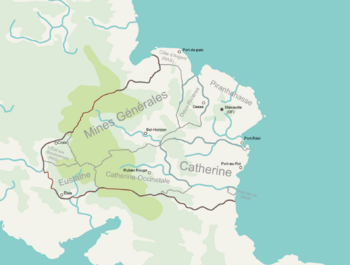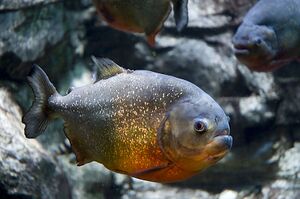Shffahkia
This article is incomplete because it is pending further input from participants, or it is a work-in-progress by one author. Please comment on this article's talk page to share your input, comments and questions. Note: To contribute to this article, you may need to seek help from the author(s) of this page. |
The Federative Republic of Shffahkia La République Fédérative de la Sfakie | |
|---|---|
| Motto: "Per ardua surgo" | |
| Anthem: La lutte finale | |
 National borders (red) State/RAS borders (grey) | |
| Capital | Shffahkiaville |
| Largest city | Port-Réel |
| Official languages | Lysian, Esperanto |
| Recognised regional languages | Havska, Limonaian |
| Ethnic groups (2017) | Percentage
|
| Religion | banned |
| Demonym(s) | Shffahkian |
| Government | Federative presidential constitutional republic |
• President | Adélaïde Larue |
• Vice President | Émeric Dutoit |
• Premier | Louque Admie |
| Legislature | Congrès Collectif
|
| Establishment | |
• First Colonial Settlement | 1498 |
• The Shffahkian Revolution | 1796 - 1801 |
• Decloration of Independece | 25 August 1796 |
• First Republic | 7 October 1841 |
• Collectivist Revolution | July 3 1904 |
• The Second Republic | 27 October 1952 |
| Area | |
• | 1,003,978 km2 (387,638 sq mi) |
| GDP (nominal) | estimate |
• Total | $2 248 billion |
• Per capita | $15 037 |
| Currency | Chaffron (Chf) |
| Driving side | right |
Shffahkia, officially the Federative Republic of Sffahkia (FRS) (Lysian: La République Fédérative de la Sfakie / RFS), sometimes referred to as the Collectivist Republic of Shffahkia (CRS) (Lysian: La République Collectiviste de la Sfakie / RCS), is a collectivist federal republic and the largest state situatued in eastern Aurelia. The capital of the FRS is Shffahkiville officially (The City of) Shffahkia, and the most populated city is Port-Réel. The federation consists of the union of 6 states, one federal district, 3 special administative regions and 1031 municipalities. The FRS is the only nation in the world to have Esperanto as an official language. It is also one of the most multicultural and ethnically diverse nations, ascribed to several centuries of mass immigration from around the world. Religion is officially banned in the country, however it is estimated that around 20% of Shffahkians still practice some form of religious worship.
Bounded by the Adisi Ocean on the east, its large river basins include a vast tropical forest, home to diverse wildlife, a variety of ecological systems, and extensive natural resources spanning numerous protected habitats. This unique environmental heritage makes Shffahkia a megadiverse country, and is the subject of significant debate regarding deforestation and environmental protection.
Shffahkia was inhabited by numerous tribal nations prior to the landing of explorer Dominique Vaugeois, who claimed the area for Fleur de Lys. Shffahkia remained a - colony until 1796. Independence was achieved in 1801 with the creation of the Empire of Shffahkia, a unitary state governed under a constitutional monarchy and a parliamentary system. The ratification of the first constitution in 1809 led to the formation of a bicameral legislature, then called the Assemblée Impériale. The country became a presidential federative republic in 1841 following the dissolution of the empire. The First Shffahkian Republic ended in 1893 when Émilien Chevotet declared himself president for life. The Federative Republic of Shffahkia under Chevotet experienced the Collectivist Revolution in 1904 culminating in the Shffahkian civil war 1904-12. In 1909, Shffahkia became the Collectivist Republic of Shffahkia, a dictatorship under Duncan Delacroix. Following Delacroix's death in 1952, Shffahkia changed its name back to the Federative Republic of Shffahkia and many democratic processes were restored. Following political skirmishes between the Esperantists and Old Republicans in the late 1970s, Nikolao Kondukanto became the third dictator in Shffahkia's history. On August the 17th following a mass shut down of the government as a result of Taillifier Vigier attempting to depose Kondukanto, Adélaïde Larue seized power by dispanding the Sénat Fédérale and declaring herself the Union President.
Etymology
Shffahkia comes from the Eztac word for Golden Village. Sfaha/Sfa'a meaning gold and Quioue/Kiiu referring to a specific type of commercial settlement often translated as village. The Eztac name Sfa'akiiu was latinized as Shfacia and lysianized as Sfahaquioue. The latinized name was later lysianized into ``Sfaquie`` which became Sfakie following spelling reforms in the early 1800s.
Geography
Shffahkia lies at the eastern coast of Aurelia where it constitutes the largest sovereign state on the continent based on land area and population. Shffahkia is known for its diverse landscape and numerous rivers the largest of which is the Pragnaise which is considered the nation's south-most border. Shffahkia encompasses four different climate zones; tropical, temperate, arid and continental. Shffahkia's climate is tropical to the north, temperate and arid to the east and continental towards the eastern inland. Due to its unique position at the meeting point of four climate zones, many climate zones within Shffahkia have starkly different microclimates.
Scientist estimate that Shffahkia could be home to over 4 million types of animals (mostly invertebrates). Larger mammals include carnivores pumas, jaguars, ocelots, rare bush dogs, and foxes, and herbivores peccaries, tapirs, anteaters, sloths, opossums, and armadillos. Deer are plentiful in the south, and many species of Aurelian monkeys are found in the northern forests. Concern for the environment has grown in response to global interest in environmental issues. Shffahkia's river basins are home to an extremely diverse array of fish species, including the red-bellied piranha. Despite its reputation as a ferocious freshwater fish, the red-bellied piranha is actually a generally timid scavenger.
Biodiversity can contribute to agriculture, livestock, forestry and fisheries extraction. However, almost all economically exploited species of plants, such as soybeans and coffee, or animals, such as chickens, are imported from other countries, and the economic use of native species still crawls. In the Shffahkian GDP, the forest sector represents just over 1% and fishing 0.4%. The natural heritage of Shffahkia was threatened by cattle ranching and agriculture, logging, mining, resettlement, oil and gas extraction, over-fishing, wildlife trade, dams and infrastructure, water pollution, climate change, fire, and invasive species well into the 1960's. However, growing concern with Shffahkian environment in the late 60's and early 70's known as the environmental awakening led to massive environmental protection laws and the creation of several nature reserves.
The issue of environmental protection has often been left to the states with some significant federal intervention.


